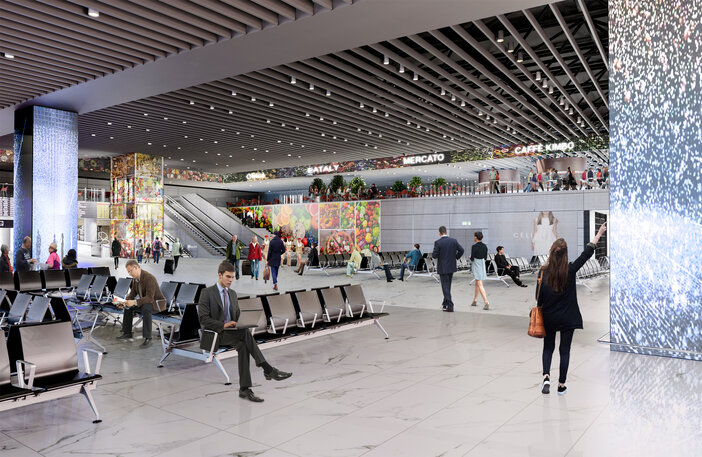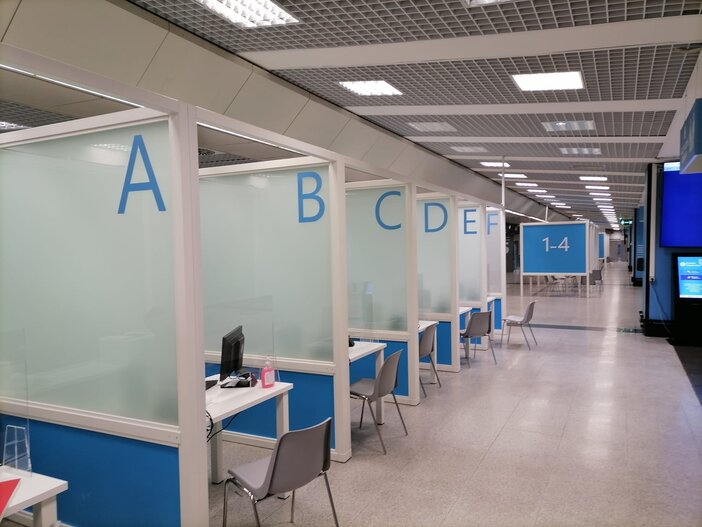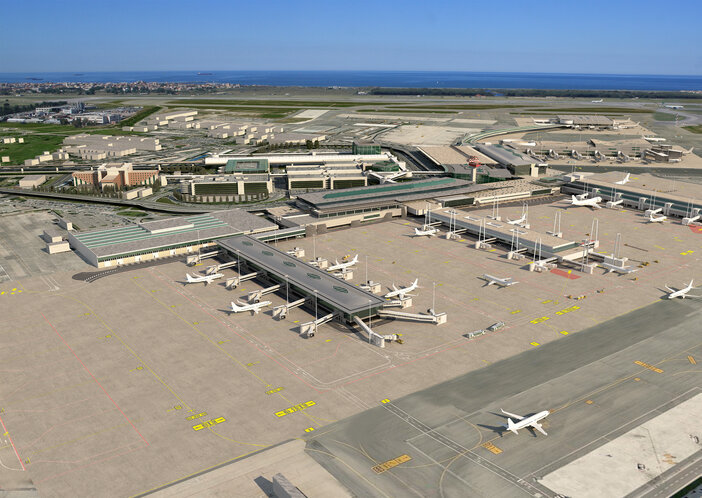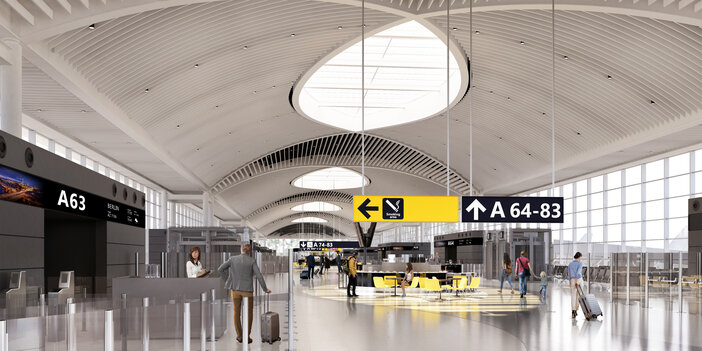On May 7, 2015, Rome’s Fiumicino Airport was hit by a devastating fire that tore through the main international terminal building. The fire, which started in Terminal 3’s retail area, caused many services to transfer to Fiumicino’s Terminal 1.
For airport operator, Aeroporti di Roma (AdR), which also runs Rome-Ciampino, the fire acted as a turning point. “I have been with AdR since late 2015,” says Gian Luca Littarru, general manager and chief operating officer at AdR. “2015 was not a good year for Fiumicino. The fire badly affected the reputation of the airport, which was already low.”
After the incident AdR embarked on an in-depth program that set out to listen to its customers’ needs and implement a continuous improvement process to enhance experience. The result has been outstanding, with Fiumicino receiving ACI Europe’s Best Airport Award in the category of over 25 million passengers per year in 2018, 2019 and 2020. This award is given to airports that have achieved excellence in various areas, including retail, security, operations, environmental awareness and customer service. Winning in 2020 meant that Fiumicino became the first airport in the history of the ACI surveys to win the award for three consecutive years.
Reputation matters
The success behind AdR’s turnaround at Fiumicino lies in a simple company policy that focuses on continuous improvements in three key areas: customer perception, passenger experience and operations.
“We have a number of tools in place to help us improve customer experience,” says Littarru. “Every year we undertake thousands of interviews with passengers on-site. We measure perceived quality and KPIs on an hourly basis, and we have developed a large team to implement improvement projects. We look at everything on an extremely detailed level to ensure quality is maintained throughout the airport. Everything is taken seriously.”
Aside from ensuring that queuing time is minimized, airport areas are kept clean and the right facilities are provided for passengers, customer perception is very important to AdR. “This goes hand in hand with experience, but we like to ensure that not only is the passenger experience as stress-free as possible, but it is also enjoyable. For example, throughout 2019 we organized more than 170 events, such as concerts, for passengers in the terminal. We have also situated pianos around the airport, so talented passengers can perform if they would like to. We recently ran an art contest, which saw contemporary artists from around the world create sculptures out of Carrera marble. These are now situated throughout our facilities. In total we have 11 exposition areas, offering to passengers archeological and art pieces to enrich the waiting times for their flight.”
In the area of operations, AdR worked hard on staff training and improving employee behavior. The company operates all its customer-facing activities in-house to ensure its high standards are met. “We don’t outsource any services,” Littarru explains. “Things like security, cleaning and PRM are all done by AdR employees. This gives us more control over the quality of their operations. This was a big driver of improvement for us.”

Getting certified
ACI Europe’s Best Airport Award was just one of many accolades given to AdR over the past year. In September 2020, for example, Fiumicino became the first airport in the world to receive five stars from Skytrax for the measures and protocols that it implemented in response to Covid-19. Meanwhile, in August 2020 Fiumicino and Ciampino became the first airports in the EU to receive ACI’s Airport Health Accreditation.
“At one point during the pandemic we had more certifications than passengers!” says Littarru. “These certifications are extremely important to us as they prove we are heading in the right direction.”
Like most airports around the world, the Covid-19 pandemic has hit AdR and its airports hard. According to Littarru, on average passenger traffic over the past 10 months has been down 90% compared with 2019 levels (Fiumicino handled 43.5 million passengers in 2019). “Non-Schengen traffic has practically been wiped out,” he says. “And even decent Schengen traffic still only represents about 20% of what we handled in 2019. Overall we are currently handling around 10,000 passengers per day across the two airports, compared with 100,000 per day this time last year.”
Being in Italy, one of the first countries to feel the impact of Covid-19 outside of China, AdR set the standard for how to handle a global pandemic at an airport. “We had a responsibility to provide a safe environment for our passengers and workers, and to ensure the financial viability of the company,” Littarru says.
AdR began talking about plans for managing the pandemic as early as November 2019. “China is a very important market for Rome and so anything affecting the Chinese we take very seriously,” he adds. “We ordered things like masks, sanitizing gel and thermal scanners well ahead of the rest of the world. Pandemic-related measures were implemented from January 2019.”
AdR then built on this by limiting access to terminals, improving wayfinding within facilities, implementing digital signage to encourage physical distancing and installing automatic, as well as manual, sanitization for escalators, elevators and security trays. All areas of the airport, including surfaces, storage trays, baggage trolleys, etc, are now sanitized six times a day and more than 100 thermal cameras regularly scan passengers for their temperature.

“We have done everything possible to position the airport as a safe place to be,” says Littarru. “We have also worked with the local community and built two large Covid-19 testing facilities – one within the airport terminal and another outside for local people. And we are currently piloting Covid-19-free flights and introducing new covid-tested flights between Rome and New York and Rome and Atlanta. Passengers are tested before departure and can only travel if they receive a negative result. We hope that more Covid-19-free routes will be added soon. We believe this approach should be used on more international and intercontinental routes – the ones currently most penalized due to quarantine.”
According to Littarru, although these flights are bringing more passengers back to the airport, they have a limit. “This type of thing would never enable us to reach decent levels of traffic,” he says. “What would enable that is if passengers could prove negativity before they arrive at the airport. We have worked with airline Alitalia to develop a new app that digitizes a Covid-19 negativity certificate for New York flights – this is the first step toward
a proper digital passport.”
Managing operations
To ensure operations continued in the most cost-effective way during the pandemic, AdR used computer simulations to define a number of different continuity plans, which are each aligned with different passenger traffic volumes. “We are able to shrink and enlarge airport operations proportionally to the traffic levels,” explains Littarru. “We are now operating with just one of the two terminals open, and one of the boarding areas, which manages both Schengen and non-Schengen passengers. In this way, we are able to limit staff, cleaning, maintenance, etc.”
AdR also had to make the difficult decision to put some of its development projects on hold, but it also accelerated others. At Fiumicino AdR is currently developing a new pier and a northwest extension to Terminal 1. The new Pier A is a two-level 18,000m2 facility, comprising 13 boarding gates and 10 remote gates for Schengen passengers. AdR is aiming for LEED Gold certification for this project. Meanwhile, the T1 northwest extension is a new three-level 38,000m2 space, which will include a new security checkpoint with 15 high-capacity lanes, a new passport control area and three new baggage reclaim belts. At its heart will be a new 3,000m2 waiting ‘piazza’ – a double-height space, with an upper balcony looking over the ground floor. It will be equipped with facilities for passengers, seating areas, a roof garden and a commercial zone.

“Before Covid-19 we were due to open the pier and first phase of the extension by July 2020,” says Littarru. “But now we don’t have a strong need for a new boarding area, so we have prioritized the first phase of the extension instead. This is set to open by October 2021. We have delayed completion of the pier and the following phases of the commercial area until around mid-2022.”
Once all current development projects at Fiumicino are complete, passenger capacity will reach 63 million per annum. For Littarru, in addition to ensuring that all new facilities are sustainable and efficient, it is also extremely important in these Covid-19 times to make sure spaces are as adaptable as possible.
He concludes, “Flexibility is essential right now. We need infrastructure and operations that can adapt to change. Currently we are operating from Terminal 3, and Terminal 1 is closed. We’ve moved many operations, including passport control for Schengen flights, to T3. New facilities will need to be designed with this adaptability in mind. Having hyper-specialized areas for airport operations is not a great strategy for the future.”
This article was originally published in the April 2021 issue of Passenger Terminal World.


